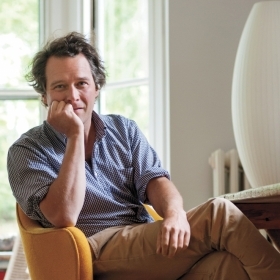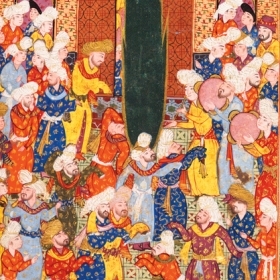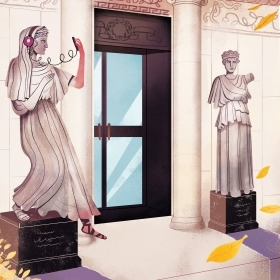“Texts have meanings that are contained not just in their words, but also in the ways in which the material carriers of those texts—books—were designed and produced,” Assistant Professor of History Simon Grote says. Think, for example, of the difference between a Harlequin romance and a scholarly edition of poetry. “When you see a book, what it means to you and your understanding of its purpose comes not just from the text, but also from the way the book looks, from the way the book feels,” Grote continues. “There are all kinds of meanings in those aspects of it that don’t come across in the text itself.”
This idea, that the text contained in a book only conveys part of the book’s meaning, has resonated in Grote’s scholarly research. He has always been interested in the history of thought, ideas, and beliefs, so he was naturally drawn to the history of philosophy. Specifically, he focuses his research on the origins of aesthetic theory, and on the writings of some of philosophy’s most prominent thinkers, including Kant, Baumgarten, Hume, Smith, and Shaftesbury.
“At the turn of the 18th century, there was an explosion of interest in understanding the nature of art and beauty,” Grote explains, “which produced an unprecedented abundance of relatively technical, psychologically sophisticated texts about what beauty is, and about what makes art good. My question is, why did that happen? In order to figure that out, I studied and tried to understand the production of several such texts.” Grote has concluded that these aesthetic theories developed in the context of a larger discussion about morality. “What these authors do is demonstrate ways in which beauty is important for moral education, such that the experience of it can enable even atheists to behave morally.”
‘The idea behind the fellowship is to introduce scholars in the humanities to the technical study of the history of production and consumption of books. This is important, because there are meanings in texts that tend to be overlooked.’
—Assistant Professor Simon Grote
To further his research, Grote received a three-year Andrew W. Mellon Fellowship for Scholars in Critical Bibliography to attend the Rare Book School each summer at the University of Virginia, where he is able to learn more about how to interpret the nonlinguistic codes that are such an important part of understanding a text.
“The idea behind the fellowship is to introduce scholars in the humanities to the technical study of the history of production and consumption of books,” Grote says. “This is important, because there are meanings in texts that tend to be overlooked. We should be thinking about more than just what the words say.” He gives the example of words: My cat jumped into the bag. “We interpret those words to mean something,” Grote explains. “But, if I showed you a physical object, a 5 in. by 8 in. hardboard book with big letters and pictures—then, the linguistic code is the same, but because it’s big letters in a board book, you understand that it’s a children’s book. What tells you that isn’t the words; it’s the stuff around it.”
For Grote, the knowledge he’s gained through his fellowship has expanded the possibilities of his discipline. To discover why a text was written, he explains, researchers need to be aware of the context in which it was produced. And, Grote believes, they can gain clues to those contexts by applying the Rare Book School’s techniques in analyzing the nonlinguistic codes of a text.
Meanwhile, Grote’s history students study their share of historical documents and texts, and he wants to ensure that they also understand more than just the words of the text by taking advantage of Wellesley’s Special Collections, where the College keeps original texts. “My role is to help my students understand how and why these texts were made, how they were read, and how they were circulated,” he explains. “I want my students to understand the historical significance of these documents. That’s not easy when you’re relying on a sourcebook. However, it becomes significantly easier when you can hold part of a class in the Rare Book Seminar Room, where we can look at texts that the College has for precisely this purpose.”








We ask that those who engage in Wellesley magazine's online community act with honesty, integrity, and respect. (Remember the honor code, alums?) We reserve the right to remove comments by impersonators or comments that are not civil and relevant to the subject at hand. By posting here, you are permitting Wellesley magazine to edit and republish your comment in all media. Please remember that all posts are public.